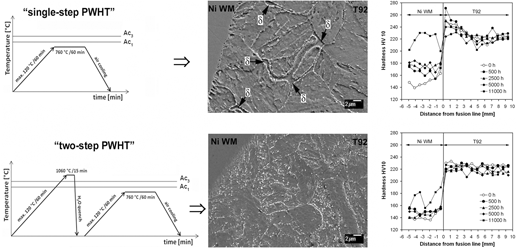Crossref Citations
This article has been cited by the following publications. This list is generated based on data provided by
Crossref.
Futas, P.
2016.
Elimination of Chunky Graphite in Castings with Large Thermal Points.
Archives of Foundry Engineering,
Vol. 16,
Issue. 4,
p.
57.
Karthick, K.
Malarvizhi, S.
Balasubramanian, V.
Krishnan, S.A.
Sasikala, G.
and
Albert, Shaju K.
2016.
Tensile properties of shielded metal arc welded dissimilar joints of nuclear grade ferritic steel and austenitic stainless steel.
Journal of the Mechanical Behavior of Materials,
Vol. 25,
Issue. 5-6,
p.
171.
Falat, Ladislav
Homolová, Viera
Čiripová, Lucia
Ševc, Peter
and
Svoboda, Milan
2017.
Ageing Effects on Microstructure, Mechanical Properties, and Fracture Behaviour of 9Cr-1.5Mo-1Co-VNbBN Martensitic Steel Welded Joint for High Temperature Application.
Advances in Materials Science and Engineering,
Vol. 2017,
Issue. ,
p.
1.
Šebek, Martin
Falat, Ladislav
Orečný, Martin
Petryshynets, Ivan
Kováč, František
and
Černík, Martin
2018.
Abrasive wear resistance of modified X37CrMoV5-1 hot work tool steel after conventional and laser heat treatment.
International Journal of Materials Research,
Vol. 109,
Issue. 5,
p.
460.
Čiripová, Lucia
Falat, Ladislav
Ševc, Peter
Vojtko, Marek
and
Džupon, Miroslav
2018.
Ageing Effects on Room-Temperature Tensile Properties and Fracture Behavior of Quenched and Tempered T92/TP316H Dissimilar Welded Joints with Ni-Based Weld Metal.
Metals,
Vol. 8,
Issue. 10,
p.
791.
Karthick, K.
Malarvizhi, S.
Balasubramanian, V.
Krishnan, S.A.
Sasikala, G.
and
Albert, Shaju K.
2018.
Tensile and impact toughness properties of various regions of dissimilar joints of nuclear grade steels.
Nuclear Engineering and Technology,
Vol. 50,
Issue. 1,
p.
116.
Cao, Fujun
Du, Chengchao
and
Smaga, Marek
2018.
Effect of PWHT on the Carbon Migration and Mechanical Properties of 2205DSS‐Q235 LBW Joint.
Advances in Materials Science and Engineering,
Vol. 2018,
Issue. 1,
Saini, Nitin
Mahapatra, Manas Mohan
and
Mulik, Rahul S.
2018.
Microstructural Evolution and Mechanical Properties of CSEF/M P92 Steel Weldments Welded Using Different Filler Compositions.
Metallurgical and Materials Transactions A,
Vol. 49,
Issue. 10,
p.
4669.
Ševc, Peter
Falat, Ladislav
Čiripová, Lucia
Džupon, Miroslav
and
Vojtko, Marek
2019.
The Effects of Electrochemical Hydrogen Charging on Room-Temperature Tensile Properties of T92/TP316H Dissimilar Weldments in Quenched-and-Tempered and Thermally-Aged Conditions.
Metals,
Vol. 9,
Issue. 8,
p.
864.
Čiripová, Lucia
Falat, Ladislav
Homolová, Viera
Džupon, Miroslav
Džunda, Róbert
and
Dlouhý, Ivo
2020.
The Effect of Electrolytic Hydrogenation on Mechanical Properties of T92 Steel Weldments under Different PWHT Conditions.
Materials,
Vol. 13,
Issue. 16,
p.
3653.
Saini, Nitin
Raghav, Rajneesh
Bist, V.
Mulik, Rahul S.
and
Mahapatra, Manas Mohan
2021.
Microstructural features and mechanical properties of similar and dissimilar ferritic welded joints for ultra-supercritical power plants.
International Journal of Pressure Vessels and Piping,
Vol. 194,
Issue. ,
p.
104556.
Thakare, J.G.
Pandey, C.
Gupta, A.
Taraphdar, P.K.
and
Mahapatra, M.M.
2021.
Role of the heterogeneity in microstructure on the mechanical performance of the Autogenous Gas Tungsten Arc (GTA) welded dissimilar joint of F/M P91 and SS304L steel.
Fusion Engineering and Design,
Vol. 168,
Issue. ,
p.
112616.
Falat, Ladislav
Čiripová, Lucia
Petryshynets, Ivan
Milkovič, Ondrej
Džupon, Miroslav
and
Kovaľ, Karol
2022.
Hydrogen Embrittlement Behavior of Plastically Pre-Strained and Cathodically Hydrogen-Charged 316H Grade Austenitic Stainless Steel.
Crystals,
Vol. 12,
Issue. 10,
p.
1419.
Wu, Guanzhi
Ding, Kai
Wei, Tao
Liu, Xia
Fan, Manjie
He, Yi
Huo, Xin
and
Gao, Yulai
2022.
Coupled effect of temperature and stress on the microstructure and stress rupture behavior of 9% Cr-CrMoV dissimilar welded joints.
Engineering Failure Analysis,
Vol. 132,
Issue. ,
p.
105945.
Sirohi, Sachin
Taraphdar, P. K.
Kumar, Prakash
and
Pandey, Chandan
2022.
Recent Advances in Manufacturing Processes and Systems.
p.
1.
Nimko, M.O.
Skulskyi, V.Yu.
and
Ivanenko, T.V.
2023.
Materials and technological approaches to welding of combined joints between martensitic and austenitic steels used in power machine building (Review).
Avtomatičeskaâ svarka (Kiev),
Vol. 2023,
Issue. 5,
p.
27.
Nimko, M.O.
Skulskyi, V.Yu.
and
Ivanenko, T.V.
2023.
Materials and technological approaches to welding of combined joints between martensitic and austenitic steels used in power machine building (Review).
The Paton Welding Journal,
Vol. 2023,
Issue. 4,
p.
11.
Saini, Nitin
Pandey, Chandan
and
Mahapatra, Manas Mohan
2024.
Microstructure Evolution and Mechanical Properties of Dissimilar Welded Joint of P911 and P92 Steel for Subsequent PWHT and N&T Treatment.
Transactions of the Indian Institute of Metals,
Vol. 77,
Issue. 8,
p.
1979.
Sarkar, Abhijit
2025.
Influence of welding heat input and post-weld heat treatment on mechanical and microstructural properties of modified 9Cr-1Mo (P91) steel in submerged arc welding.
Welding International,
Vol. 39,
Issue. 4,
p.
309.
